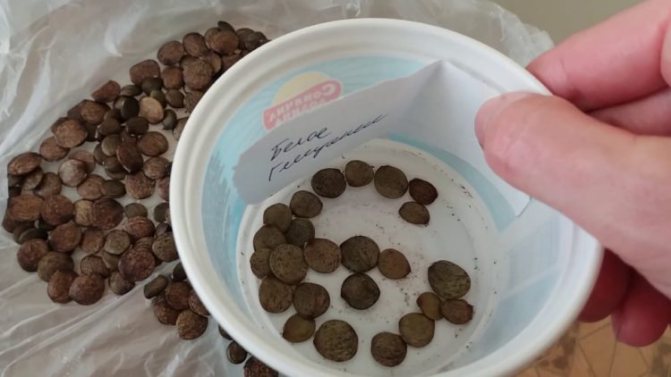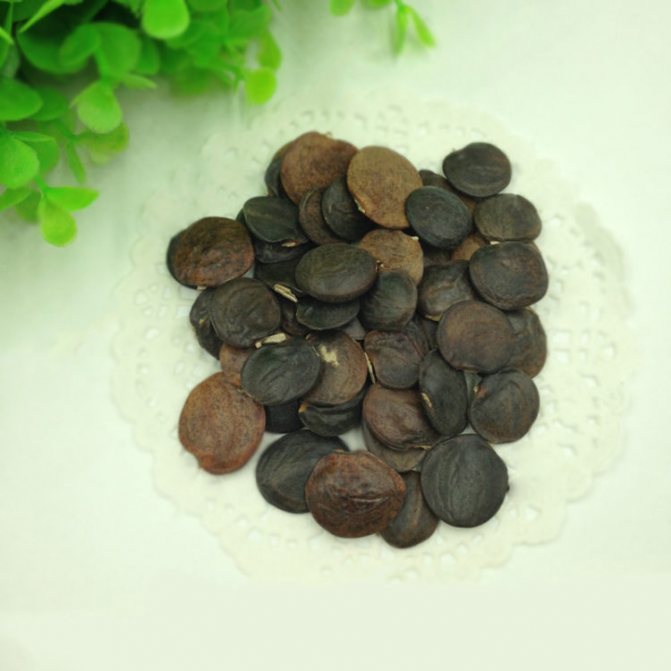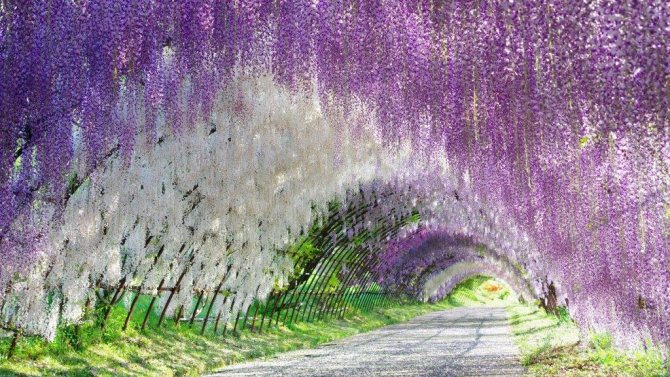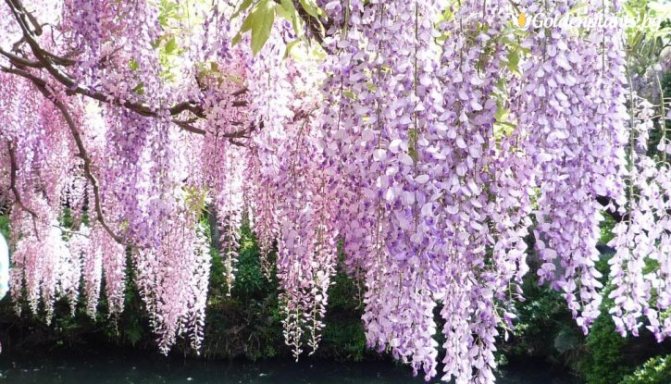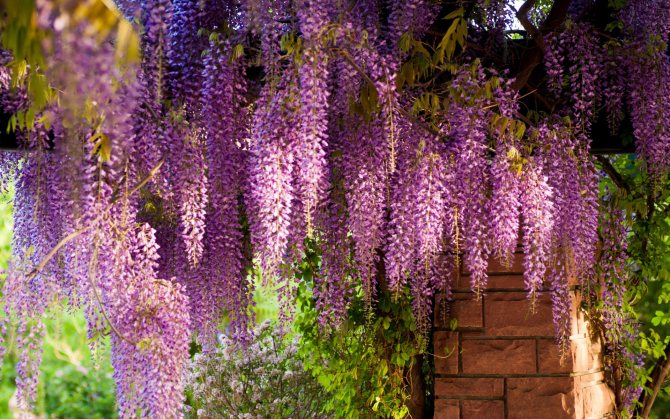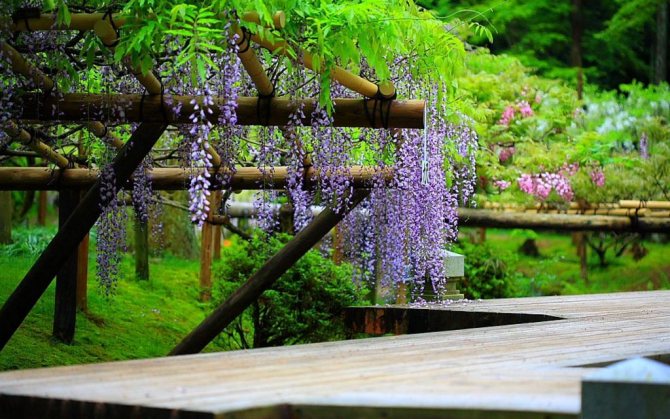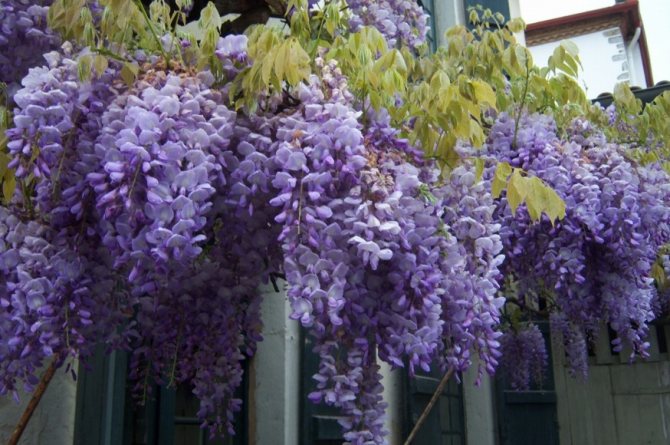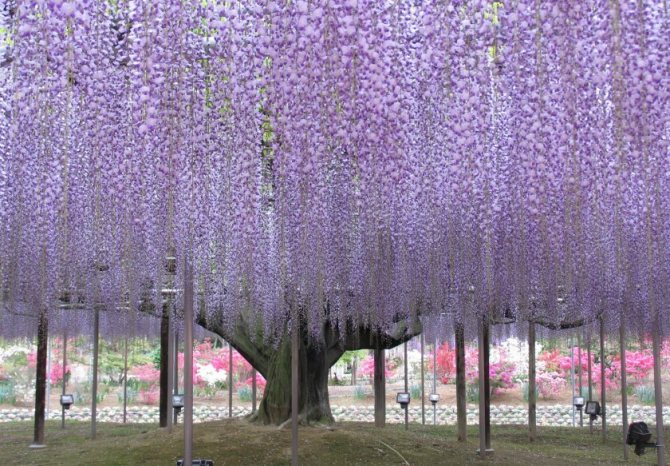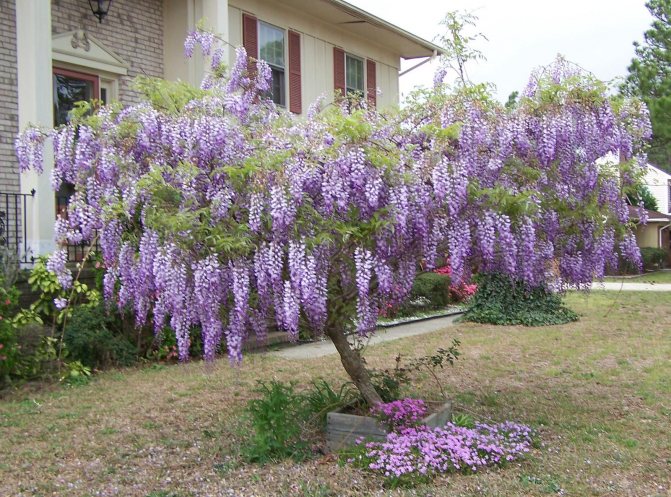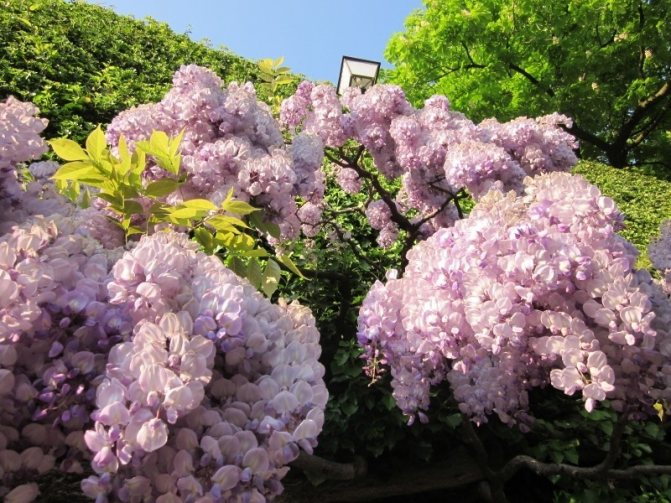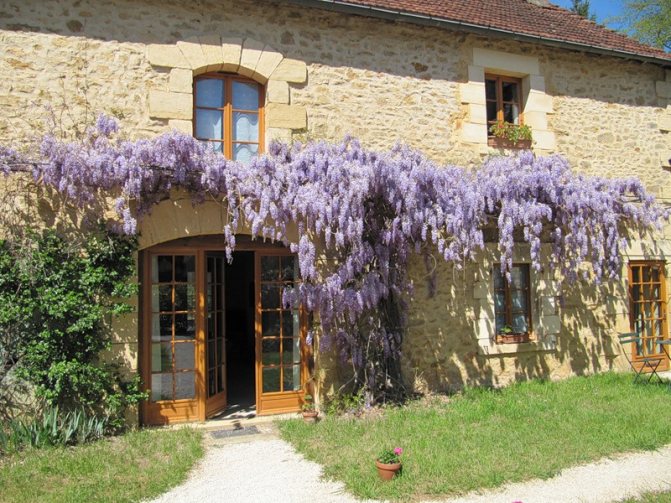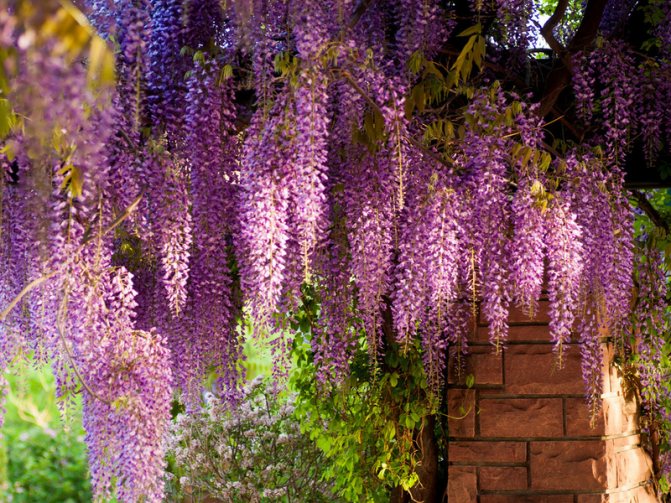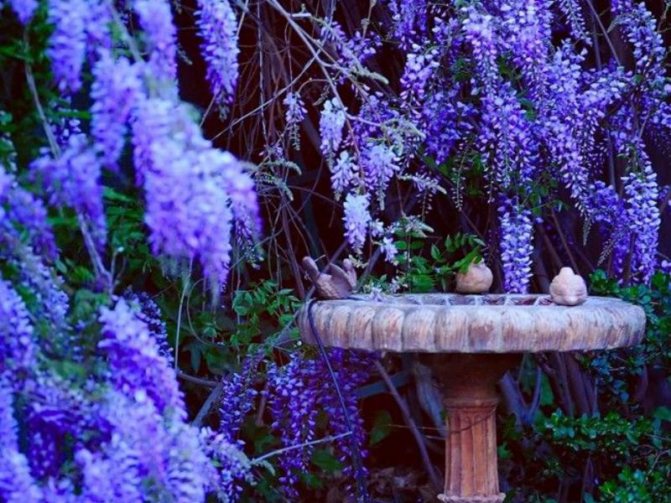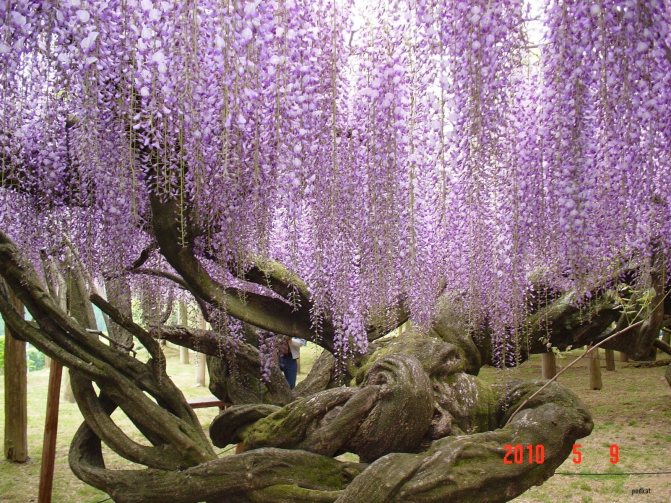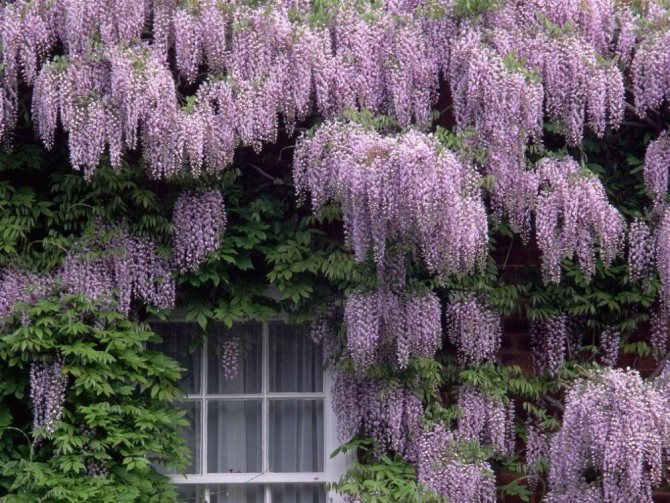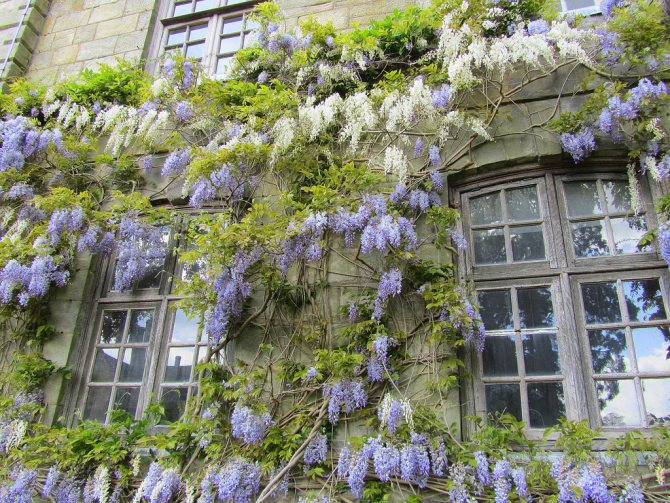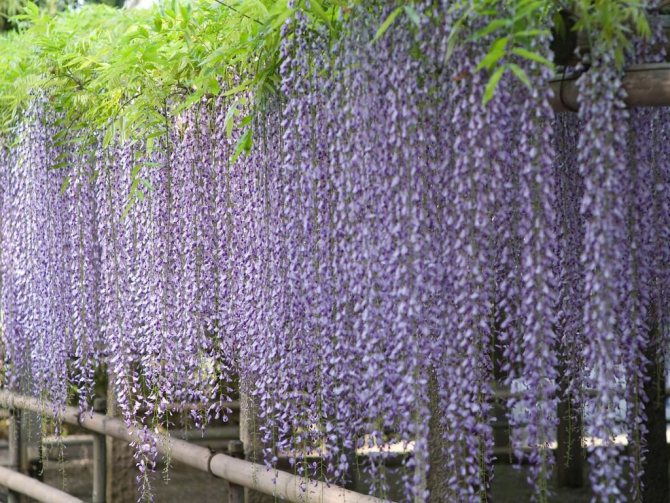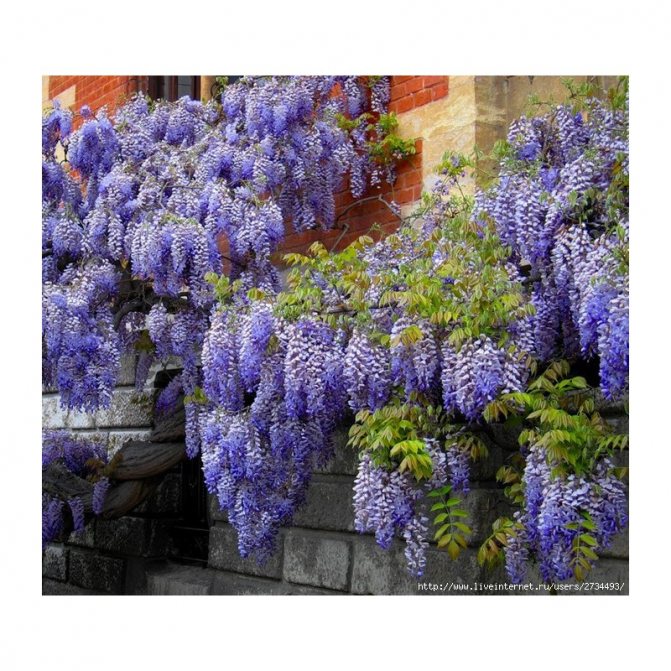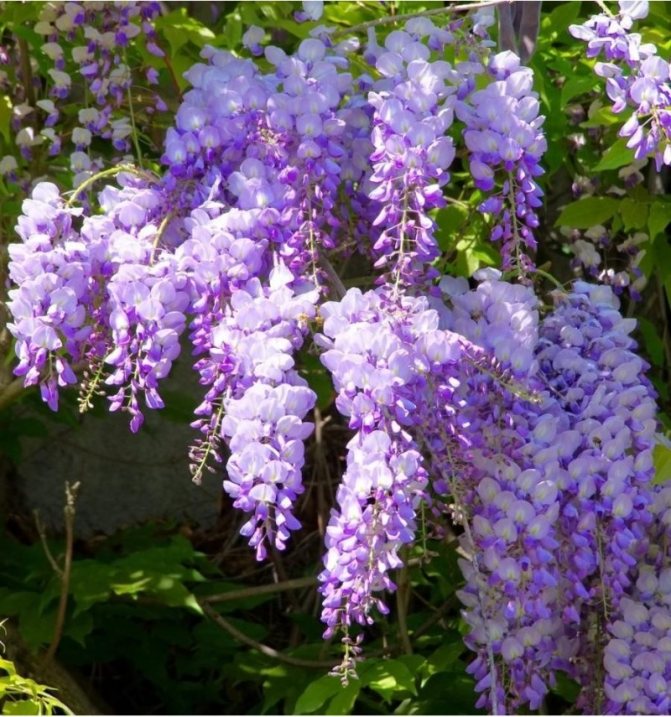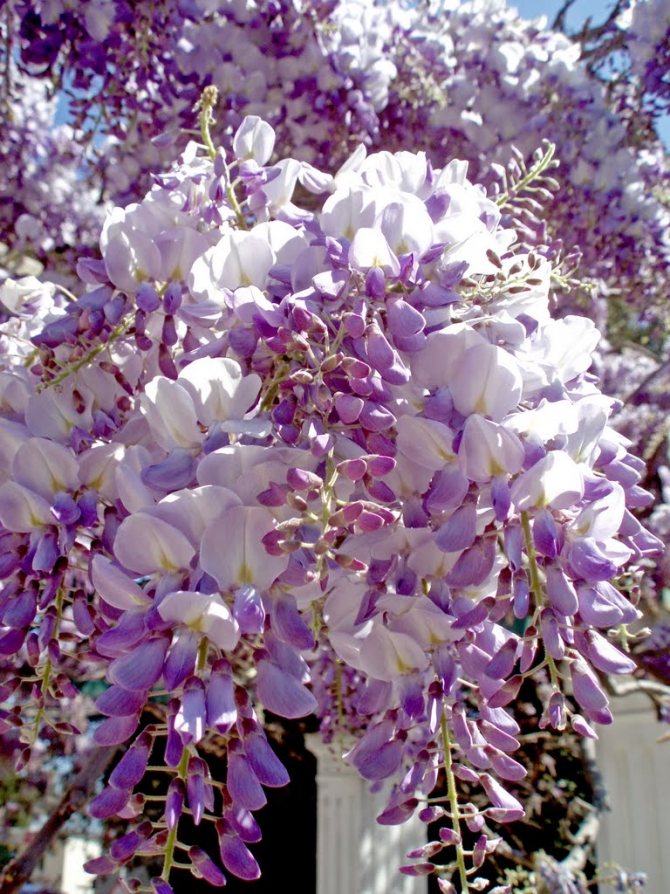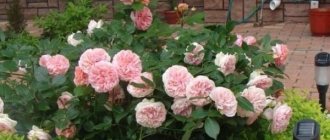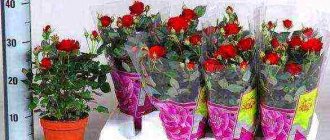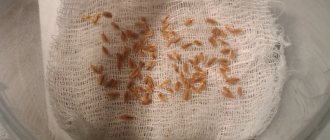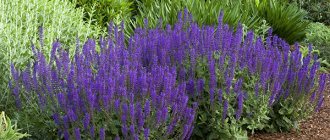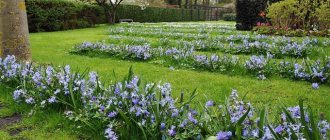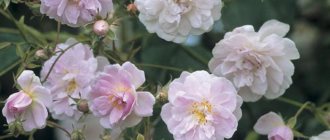Those who are lucky enough to see it during flowering will not forget the wisteria until the end of their days. The lucky ones who live in the southern regions - they can admire the blooming of wisteria in their own garden, and the inhabitants of the north, whose destiny to wrap their houses with modest girlish grapes, secretly dream of a bright and lush southerner in their garden. Wisteria is a thermophilic plant. In the Crimea, the Caucasus and Transcarpathia, it blooms very abundantly and for a long time. To the north, it blooms weaker and needs winter shelter.
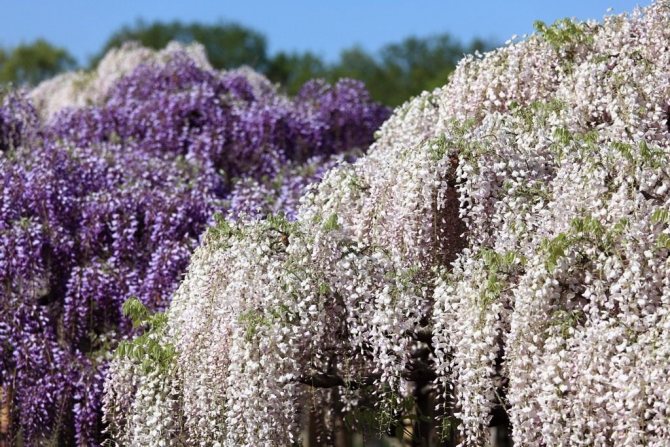
Wisteria is profusely flowering. Ashikaga Flower Park, Ashikaga, Tochigi Province, Is. Honshu, Japan. <>
Types and varieties of wisteria
According to the information specified in the The Plant List database, this genus includes only nine species and a huge number of varieties.
Chinese wisteria
W.sinensis is a plant up to two dozen meters high, with stems twisted counterclockwise and pubescent young twigs. The foliage is of the next arrangement, not paired-pinnately-divided, with narrow-ovate pubescent leaves. Inflorescences are racemose, large in size, multiflorous, fragrant, with a bell-shaped calyx and a curved pistil. The most popular variety of this variety is Sapphire.
Shrub wisteria
Deciduous liana W. frutesens up to 10-12 m high, has drooping branches. Frost-resistant and highly decorative plant is distinguished by a large number of flowers and inflorescences, up to half a meter long. Garden forms have white, pale pink or double purple flowers and attractive variegated foliage. Varieties of this type are highly valued for long and white flowering, as well as very attractive fruits. One of the most popular varieties in the Rostov region.
We also recommend reading:
16 of the most popular indoor plants Physalis: description of species and varieties, technology of growing from spruce seeds in landscape design: the best decorative varieties and features of growing Kalanchoe: description of species and features of care at home
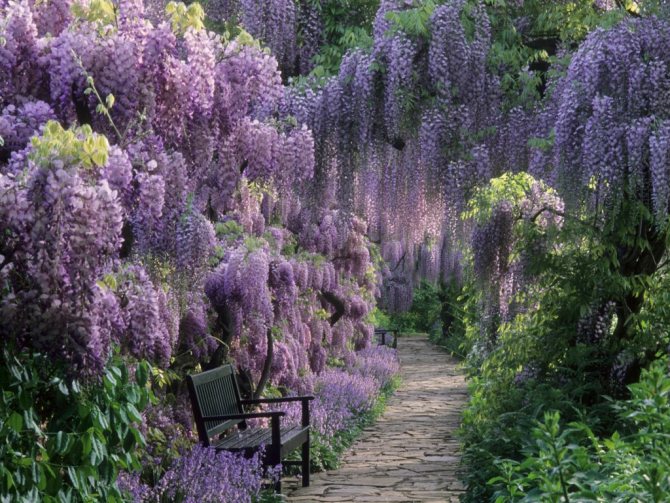

Shrub wisteria
Japanese wisteria
The relatively compact variety W.jaronis is a more compact tree-like plant, with a height of the aboveground part of no more than ten meters. It is characterized by rather small lilac flowers with a bluish tint. There are also garden forms that form flowers of pink, bright purple or white.
The variety W.floribunda is distinguished by the height of the aerial part up to ten meters, with rather large foliage and a large number of inflorescences. Flowers are not too large in size, delicate violet-bluish coloration. The tree culture is rolled counterclockwise onto the support table and is characterized by excellent frost resistance. The most popular garden forms are represented by Alba with white flowers, rosea with pale pinkish petals, violaceo-plena with purple double flowers, as well as large-flowered ornamental varieties Masrobotrys and variegated variegata.
What the seed looks like - photo, tips for choosing
Depending on the variety of wisteria, the color and size of the seeds differ. For example, the seeds of white wisteria are smaller than those of lilac.The characteristic shape for most seeds is round, the color is from dark brown to light beige with a greenish tint. Choose seeds for planting dry, without mold, dents and cracks.
Determine which vine variety is right for your climate. Note that out of nine types of wisteria in central Russia, three take root: Chinese wisteria, multiflorous and shrub. The choice of the variety also depends on the color preferences of the gardener, as well as on the compositional plan of the site.
In the photo you can see what the wisteria seeds look like:
Botanical features of blue moon frost-resistant wisteria
The Blue Moon variety is characterized by excellent frost resistance, therefore, such an ornamental crop is able to withstand a decrease in temperature to minus 39-40 ° C. The height of the aboveground part does not exceed 6-7 m. The flowering is very abundant and long lasting, during the period from early summer to about mid-September. The flowers are large in size, up to 2.3-2.5 cm in diameter, lavender-bluish. A flower raceme up to 28-30 cm long. The presence of quite numerous dormant buds and a well-developed basal growth allows the ornamental culture to recover from tangible spring frosts as soon as possible.
Seed material from China - pros and cons
It is not always possible to collect seeds of the desired variety on your own. Then make a purchase in a store or order online from China.
Pros:
- Large selection of seeds.
- Price: the cost is lower than in the store.
- Convenient: the order is placed in a couple of clicks.
Minuses:
- Due to transportation, the seeds are deformed, this affects germination.
- If the package is not airtight, the seeds will become damp and covered with mold. It is almost impossible to save such material.
- Place each seed in a separate order. It happens that the variety is not indicated on the package, there is a chance to confuse the seeds.
- Low seed germination compared to hand-picked.
Gallery: varieties of wisteria (80 photos)
Description
Shoots of wisteria are dense, branched, woody, up to 8-15 m long. They are creeping or erect. Juveniles are light green or brown, adults are covered with brown or dark gray bark. Leaves are bright or dark green, pinnate, smooth or slightly pubescent. A composite leaf up to 25–40 cm in size consists of 7–15 elliptical elongated lobes with pointed tips, located on short petioles.
The blooming period of wisteria begins in the last days of March.... The buds are small, 2-3 cm in diameter, five-petal, resemble the wings of butterflies, with a light aroma. Collected in long, loose clusters hanging at the ends of the shoots or in the leaf axils. The color is white, cream, pink, lilac, lilac.
Fruits are pubescent legume pods 10–15 cm long with several simplified grains inside.
All parts of plants contain poisonous phytoncides that are harmful to pathogenic bacteria and fungi. It has been established that wisteria destroy Koch's wand.
Wisterias are quite frost-hardy, despite their subtropical origin.... They are able to withstand cold temperatures down to –15–20 ° C.


Features of growing and caring for wisteria in the Moscow region and the middle lane
To grow an ornamental perennial, it is necessary to choose a sunny location, which is represented by light and well-structured soils. To get large inflorescences, the culture needs to provide a sufficient amount of light, and the period of illumination should be twelve hours or more. When planting, it is advisable to lay a drainage layer that will prevent the accumulation of water in the root system of the plant.
Blue moon variety is characterized by excellent frost resistance
It is necessary to plant seedlings in specially prepared planting holes, the depth of which should be about a quarter of a meter.Fertilization of planting pits with humus and mineral fertilizers is mandatory. Irrigation activities are performed every day. A very good result is obtained by mulching the soil in the near-trunk circles.
In addition to watering, the main mandatory care measures include fertilizing with organic and mineral fertilizers, as well as pruning that forms a neat and attractive crown. Among other things, it is important to carry out preventive materials. To protect against clover mites, treatment with acaricidal compounds is carried out. Caterpillar control is carried out by spraying with biological agents, and aphids should be destroyed with insecticidal agents.
Content
- Listen to the article
- Description
- Growing wisteria from seeds Sowing
- Seedling care
- When to plant
- How to grow
- Chinese wisteria (Wisteria chinensis)
Planting dates and rules for growing wisteria in the open field in Ukraine and Belarus
Soil and climatic conditions on the territory of Belarus and Ukraine are very favorable for growing a flowering plant. After planting ornamental liana seedlings, it is necessary to mulch the young wisteria with organic matter about 10 cm higher than the plant's neck. For this purpose, peat chips or dry composted grass stand can be used. The mulch is laid out as evenly as possible and should not be removed throughout the year. In the summer, a properly executed mulch layer helps to protect the root system of a garden flowering tree from overheating, and in winter frosts, on the contrary, it helps to avoid severe frostbite and freezing of the culture. Formative and sanitary pruning is carried out twice a year, as well as the processing of the crown with "Vitaros", "Fundazol" or "Previkur".
Advantages and disadvantages of the method
Let's describe the advantages and disadvantages of the seed propagation method.
Pros:
- A simple method, a beginner can handle.
- Seeds remain viable for up to three years.
- Seedlings grown from seed are hardy, resistant to changing weather conditions. The method is effective for cold regions of Russia.
- Sometimes seedlings are superior to their parents in decorative qualities; these plants are used by breeders.
- Cheap method: seeds are 8-10 times cheaper than a seedling.
Minuses:
- Seedlings bloom in 4-9 years.
- The decorative properties of vines are not always preserved.
- Poor quality seeds give a germination rate of 25-30%.
Growing wisteria in Siberia and the Urals
Despite the fact that wisterias are very simple in culture, they can grow on almost any type of soil, the issue of choosing a site for planting and observing the rules of care must be approached very carefully, due to the difficult soil and climatic conditions in Siberia and the Urals. Preference should be given to sufficiently fertile loams or chernozems with neutral or slightly alkaline pH values. The garden vine is very drought tolerant., especially mature plants, but regular and abundant irrigation activities have a positive effect on the quality of flowering.
The ornamental culture is distinguished by its responsiveness to the application of mineral fertilizers, and the introduction of 250-300 g of Kemira-Universal fertilizer into the planting hole allows the planted seedlings to grow four or five very well-developed shoots within one year. But, need to rememberthat any "fattening" plants need mandatory shelter for the winter in the first place. A powerful and tall liana is required to provide reliable support.It is best to place plantings near the southern wall of the home, as the wall is a very good heat accumulator and allows the garden tree to survive easily during the winter.
Immediately before the onset of a significant cold snap, in the area above the root system, it is required to lay insulation, which is most often used as moss or peat chips. It is especially important to use insulating materials in preparation for the winter period of young or recently planted ornamental plants. Also, the insulation of the aboveground part of the tree-like garden culture has good performance. In this case, it is advisable to use special non-woven covering materials.
Wisteria is grown not only in the open ground of the garden, but also actively cultivated in traditional flower pots, as well as in flowerpots or tubs.
How to grow wisteria?
Wisterias - fast growing plantsthat immediately cling to any possible support. This quality has made them popular with both landscape designers and novice florists who appreciate the romantic style.
A developing liana requires a frame made of thick reinforcement, steel or wood. The more mature the plant, the thicker the stem and the heavier the green foliage. Small wisterias look great in pots as indoor flowers. The pot must be wide and equipped with a sturdy steel rod. Moreover, the vine looks great in a pot on the loggia.
Planting creepers in a personal plot will require reliable support... A lot of effort must be made and pruning creepers. A heavily overgrown, massive plant will break under its own weight without proper pruning.
An ideal place for wisteria on a personal plot is a house facade, well-lit by the sun, a gazebo wall, or a special shed. Chinese wisteria needs constant warmth. Only under the sun will it bloom beautifully with a lot of inflorescences.
Experienced flower growers know that all varieties of this vine are quite capricious. Planting and grooming require great care. There are a number of rules to keep in mind:
- liana, which is planted from seeds, will begin to bloom only after 8 years;
- seedlings purchased in stores take root up to 4 years old, before sprouting flower buds;
- before flowering weekly, it is necessary to fertilize the soil near the roots;
- it is not necessary to water the vine strongly, but constantly;
- sometimes the plant does not bloom at all for several years. This vine needs to be "pushed" by adding potash groundbaits to the ground in the fall;
- it is advisable to avoid nitrogen additions. In legumes, nitrogen creates a strong deciduous mass, but not the formation of inflorescences.
Pruning
For a more beautiful flowering, the plant requires prune 2 times a year... Large branches form in the summer, after a couple of weeks, when the brushes dry and fade. In this case, you can correct the wireframe. Small vines are pruned in the fall.
In winter, these manipulations with wisteria cannot be performed. In winter, the vine forms buds of inflorescences, and the most beautiful and large ones can be accidentally cut off.
In the fall, it is necessary to remove all dead parts of the shrub that interfere with the germination of young branches. Experienced gardeners recommend looking at the vine from a distance of 7 steps. This way you can better see the difference in color on old branches and new shoots that grow from them.
Side branches need shorten to 20 cm... The old branches are also made smaller so that there are only 5 buds. This will help the vine to concentrate its vitality on creating inflorescences on short branches.
In the summertime, you can perform the same procedure with side branches, leaving a few leaves on each shoot. It is necessary to cut off large "clinging" branches in the form in which they decided to line the vine. Pruning won't do any harm.Elastic shoots They will grow quite quickly, and will fix where they are directed.
How do I prepare the seeds?
Large pods make the plant look less attractive in spring. It is advisable to cut them without removing a significant part of the stem, as there may be buds of inflorescences.
You can plant this plant from seeds that are collected from the pods. Remember - the new plant will not be identical to the mother vine.
Ripened pods placed in a large cardboard bag and left to dry in a warm place. For example, you can leave a package on the torpedo of a car for several weeks. When the pods are open, the seeds are easily removed from the shell.
For cultivation, planting in a deep pot is required. The seeds are deepened into the ground by 3 cm and watered. It is advisable to use a mixture of soil with the addition of sand for growing. The seed pot must be placed in the shade. Many growers cover the pot with glass to protect against heat loss. During germination, it is necessary to add water so that the soil is constantly moistened.
When the shoots appear, the pot must be rearranged to a lighted area (not to direct sunlight). When the shoots form several leaves, they transplanted into different containers... Do not transplant small seedlings directly into the ground. Liana must grow at least 25 cm.
How to grow wisteria in the suburbs?
The natural habitat of this plant is the tropics. In the northern regions, the liana suffers from frost. Many varieties of lianas cannot even endure autumn in our climate. The minimum temperature for a plant should be at least 10C. Even when the roots survive in the soil and then create shoots, the frozen specimen will not discard the inflorescences for a long time.
This plant in the Moscow region develops well only with special protection in the winter. Florists do not place seedlings in the ground in the first spring, but they are planted in special barrels. For escapes a container with a volume of 45-55 liters is required... Liana needs strong support, as well as a garter.
In the fall, you need to keep an eye on the weather forecast. If the temperature drops below 15C at night, the plant must be moved into the house. It is desirable that it be a basement or cellar.
In winter, the vine is inactive. The plant does not need bright lighting, watering can be done every 7 days. In a highly heated and bright room in winter, the vine will die. Already from the beginning of spring, the barrel with the plant is moved to the bright part of the room, and watering is carried out every two days. When the temperature at night will be more than 10C, the vine can be placed on open ground.
An adult liana needs to be spud before winter. In this case, the plant is removed from the supports, fixed to the ground and covered with straw, leaves, unnecessary clothing. By this time, the bulk of the shoots must be cut off. With secure cover, wisteria can tolerate temperature about -22C.
Caring flower growers achieve the survival of the plant for many years, as well as double flowering of wisteria. Growing vines from maternal vines makes wisteria more resistant to frost.
The main disadvantages of wisteria
Certain natural specifics This plant can greatly perplex the grower who first grew wisteria:
- you should not choose a living tree as a support for this plant. Liana will eventually "strangle" the tree with powerful lashes. The plant can only be fixed near dead and dried trees;
- the vine develops late foliage in spring. Its bare branches will begin to contrast with the greenery of the rest of the plants that has appeared;
- flowering is not constant, and not intense all the time;
- in hot weather, the leaves of this plant acquire a dark brown hue;
- the increased allergy and toxicity of liana pollen makes it impossible to grow it in the backyard, where small children often walk;
- the foliage and fruits of the creeper are very poisonous.After contact with the plant, the whole body should be thoroughly washed with soap.
Chinese wisteria creates a magnificent romantic atmosphere on the backyard. This vine can fit perfectly in any landscape design, masks the facades of old houses, as well as dead trees. The aroma of blossoming inflorescences is very pleasant to the sense of smell, and also clears the air space from pathogens. Caring for a vine is quite difficult, but the result will reward you for all your efforts.
Growing wisteria
Secrets of growing wisteria at home
Wisteria is grown not only in the open ground of the garden, but also actively cultivated in traditional flower pots, as well as in flowerpots or tubs. The soil for indoor wisteria must be light and nutritious enough. When self-preparing a nutritious loose, moisture-permeable planting substrate based on four parts of leafy soil, one part of sod land and one part of medium-grained clean sand.
In the warm period, such a plant can be grown outdoors in the open air, but when the first noticeable cold weather comes, it is brought into the room. Very importanto when cultivating an ornamental culture at home, maintain air humidity values within 65-75%. For the winter period, the home culture is best placed in a room with temperature indicators not exceeding 10 ° C. A good option is a frost-free basement.
Irrigation measures in winter should be moderate enough. With the onset of spring, it is necessary to carefully but carefully cut off all young shoots. Lateral branches are pruned in spring with a sharp and clean pruner to two or three well-developed buds. Such events allow you to form a very beautiful and highly decorative crown. With the onset of summer, the decorative liana-like culture in a pot or flowerpot is again taken out under the open sky and watered very well.
Flowers or liana wisteria - description and photo of the plant
Among florists, there are constant disputes over the definition of the species of this plant. Flowers or liana? Rather, a tree.
Wisteria belongs to the legume family and naturally grows in the southern and tropical regions. Does not experience any problems with growth, development and abundant flowering in the climatic conditions of the Crimean Peninsula, Kuban, North Caucasus, Mineralnye Vody.
It is there that you can see unusual tunnels, entwined pergolas and decorated hedges using similar vines.
When describing a plant, it should be immediately clarified that in cold, harsh and long winters, only the root system and young growth can be preserved. And flowering occurs only on vines that have reached the age of 6-8 years.
Moreover, in the suburbs in the conditions of a cold and rainy summer, it is extremely difficult to force wisteria to bloom. She needs an abundance of sunlight and a constant ambient temperature without sudden changes in the night and day.
Under suitable growing conditions, the wisteria flower blooms 2 times per season. The first brushes bloom in early spring until the feathery leaves appear. The second wave of flowering occurs in early August. The Latin name for the culture is Wisteria.
It is a ligneous liana that does not grow rapidly. Usually, during the season, an increase in the vegetative mass of the shoots is achieved only by 20 - 30 cm. It can grow to the height of the wall 5-7 years after planting.
A large deciduous mass perfectly decorates any surface, but racemose inflorescences, the length of which reaches 35 cm, are of particular interest.
Look at the photo of wisteria at the time of its flowering - this is a magnificent sight, striking the imagination with its beauty and grace:
Plot decor
Small arch-canopy made of subtropical liana
In creating a hedge, decorating the facade of a house, a fence or a wall, a liana is ideal. Chinese and lush-flowered wisteria is also suitable for decorating gazebos, pergolas, terraces, balconies.
Wisteria is a striking example of vertical gardening: it occupies an insignificant area and looks very unusual. Liana received the nickname "garden climber" for her ability to quickly move along the support and create a green screen.
The plant perfectly hides all the imperfections of the garden plot or outbuildings, protects the secluded corner of the garden, where it grows, from the wind and sun.
Other flowers are planted next to the wisteria, which are combined with its color scheme. The adjacent heads of white tulips, spots of purple hyacinths, yellow daffodils interspersed will add completeness to the landscape and enhance the decorative effect.


The decor of the area where wisteria looks like an additional decoration
Wisteria grows in flowerpots, pots or pots, which are displayed in greenhouses or conservatories, where a small standard tree is created from it. But more often it is used as a garden plant. Indoor culture is a rather rare occurrence, since it requires a large area and careful maintenance.
Wisteria is an unusual ornamental crop. Its bloom is a breathtaking sight that defies comparison. Unfortunately, the inhabitant of the subtropics did not take root in the middle latitudes of our country. But fans of the exotic should not be discouraged: there are options for growing vines in indoor conditions. And although this is not an easy and time-consuming process, but the "subtropical beauty" is worth it.
See also: Clematis: description, classification of varieties, cultivation, planting and care in the open field (50 Photos & Videos) + Reviews
Plant in the garden: how to plant?
Many are interested in how frost-resistant wisteria will grow in the Moscow region. Proper cultivation and care begins with the selection of a seedling and preparation for planting. For cultivation, it is necessary to prepare slightly alkaline loosened soil. It should be well drained before planting. It should be borne in mind that wisteria will grow better on fertile soils. For digging, you need to add a little complex mineral fertilizer.
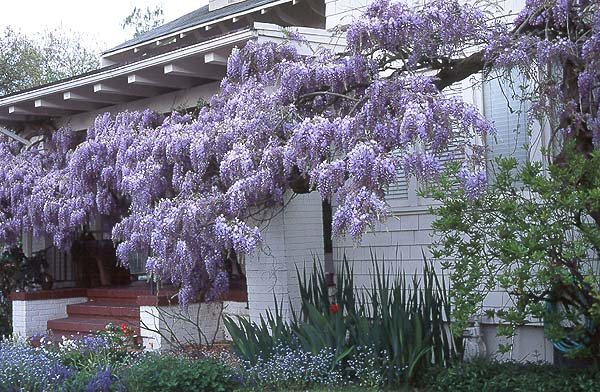

Wisteria becomes more hardy with age. What is frost-resistant wisteria afraid of in the Moscow region? Care and cultivation of this plant should be carried out taking into account one important requirement: this culture does not tolerate drafts. Landing should be organized in a calm, comfortable place.
A depression of at least fifty centimeters should be prepared. A good drainage layer must be laid on the bottom. This will provide reliable protection for the plant roots. So they will not be flooded by groundwater.
Tree liana and landscape
Wisteria blooms unforgettably, because the colors of its long inflorescences are cast in blue, red and white shades.
Huge brushes gently descend, enveloping those around them with their sweetish aroma.
The beauty of wisteria is appreciated by landscape designers from all over the world, because this plant mesmerizes with its exuberant beauty.
Of course, it is quite difficult to grow a huge plant with lush inflorescences on the territory of our country, but if you put in a little effort, you will certainly be able to achieve good results.
Reproduction


Gardeners use the following 2 methods to propagate wisteria:
- plant by seeds;
- grow this woody vine by layering.
The method of propagation by seeds is more laborious. First, in November or December, they are planted in a mini greenhouse. You can sow seeds in the spring directly into the ground.
Before planting, it is necessary to properly prepare the soil, it must be loose.It is useful to make a mixture under the seedlings by combining leaf turf, sand and turf soil.
After planting the seeds, the greenhouse is covered with glass or plastic wrap to maintain high humidity. The container is removed to a dark place, at this point gardeners should pay attention.
Seedlings will appear in 3-4 weeks. After that, the seedlings are brought out into the light, slightly shaded. This must be done so that the bright rays do not damage the delicate greenery. After the appearance of 1-2 leaves, the seedlings dive.
Gardeners propagate liana by layering, this is an easier way. To do this, you need to choose annual shoots, they must be ripe. It is best to use those of them that have reached a length of 20-25 cm. They are rooted in a soil mixture, into which humus and sand are additionally introduced. When the cuttings are rooted, they are planted in a permanent place. This is best done at the end of the summer.
Establishing indoor and bonsai culture
Alternatively, indoor wisteria is grown. This is convenient for the northern regions, where, in harsh climatic conditions, it is not able to overwinter. Liana can only be kept in a spacious apartment. Even with periodic pruning, wisteria grows up to 2 m. She is decorated in a hall, hall or placed in a winter garden.


Exotic wisteria bonsai
In the autumn, the vine is planted in a small container and left in a dry and lighted room with t = + 15- + 20C. Shoots are formed in early spring so that the standard tree does not grow much. He is left in the apartment, taken out to the balcony, veranda or garden.
Wisteria bonsai is becoming more and more popular. Despite its large natural size, it is quite possible to form a small dwarf tree from it.
This is due to the qualities of vines such as:
- plastic
- ability to grow rapidly
- undemanding care
- unusual appearance
Its creation will require some effort, but the result is worth it. This is a real indoor exotic that can change the interior of one of the corners of the room.
back to menu ↑
See also: Garden azaleas: description, varieties, planting and care in the open field, preparation for wintering (50 Photos & Videos) + Reviews
How to choose a place for a plant outdoors?
Not recommended to be planted next to live trees, as it becomes stronger over time and can simply "strangle" a neighbor, wrapping its branches around him more and more tightly.
It is good when the creeper has the opportunity to "grab" a good strong support that will withstand even in strong winds. Do not expect the wisteria to wrap around the whole support itself, help it, tie it up, and then, when preparing for the fall for the winter, there will be fewer problems.
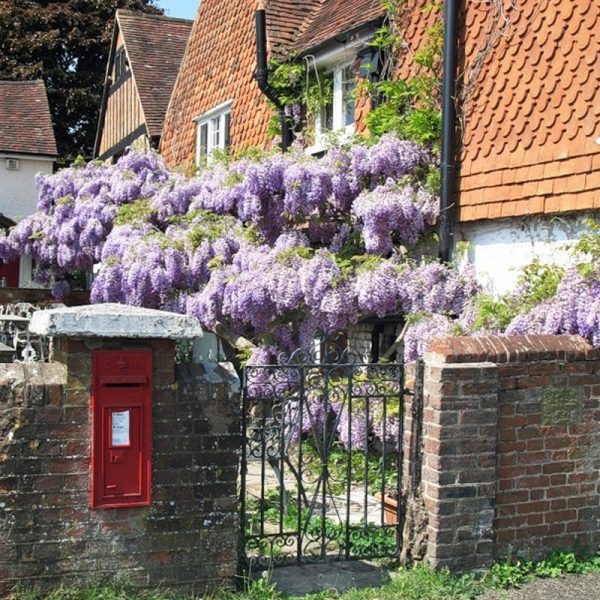

Ideal side for placement - sunny


Wisteria needs support and a garter
Choose a sunny side when planting. Wisteria must be in the sun all the time if you want it to bloom.
Botanical portrait: what makes a plant attractive
Wisterias are tree lianas from the legume family, native to China, Japan, and Korea; some species were introduced and introduced in the eastern United States and ran wild there. In ornamental horticulture, they are grown all over the world, but prefer the humid climate of the subtropics.
Translated from Greek, the name of the plant sounds like "sweet" and is associated with the fragrant smell of flowers. The synonym "wisteria", repeating the Latin name Wisteria, is associated with the surname of the American scientist K. Wistar.


Fast-growing wisteria pagons can rise up to 20 m, and spread up to 10 m in length. The world's largest representative of the genus, planted in 1894 in the Sierra Madre of California, covers an area of 0.40 hectares and weighs almost 250 tons. The leaves of the plant are odd-pinnate, 15 to 35 cm long, arranged alternately along the pagons, consist of 9-19 lobules.
The real wealth of lianas are lush domed inflorescences-brushes with a length of 30-50 cm, in some varieties they reach 80 cm, drooping down.
Flowers are usually lilac-blue in color with a violet at the base of the petals, but there are also pink or white. Blossom in spring before foliage appears.


The seeds ripen in long, thin pods and are poisonous - they contain significant levels of glycerin.
Choosing a place and soil for growing
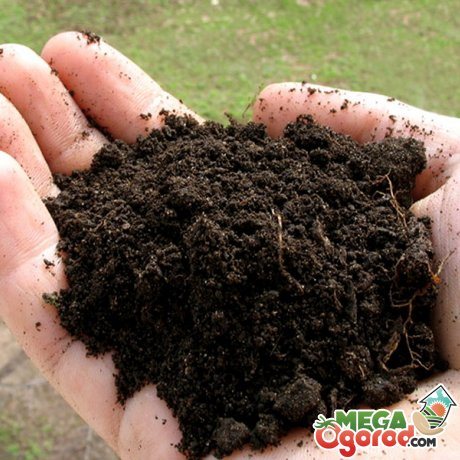

In order to not get a shabby shrub with non-viable buds after planting a plant, it is recommended to choose a proper seedling, a place for planting before planting work. It is necessary to prepare in advance the soil in which the plant will be placed.
In order for the plant to grow into a strong and powerful tree, you should not buy it from your hands, but contact a specialized nursery and purchase a high-quality, strengthened seedling.
It is recommended to purchase a seedling with a closed root system. This is due to the fact that in such conditions the plant will take root faster, it will not acclimatize for a long period. When purchasing, you should carefully examine the seedling - it should not have dark spots, damage or other signs of pests settling on the plant or the attachment of diseases.
After choosing a seedling, you should go to the choice of a place for planting. This procedure requires the following guidelines to be followed:
- The place should be open, not shaded by neighboring fruit plants. The shrub should be in a sunny area, or at least in an area where the sun is present in the morning.
- The site where the vine is going to be placed must be protected from cold northerly winds and penetrating drafts.
- Do not plant wisteria next to other fruit crops. Primarily due to the fact that mature trees will clog young shrubs, absorbing all nutrients and moisture. Secondly, wisteria at a young age grows rather quickly, so it can crush other plants not only by the strength of the roots, but also by the strength of the vines, which will invariably spread to a nearby plant.
- Before rooting, you should think that wisteria is a climbing plant, it needs support. In the form of a support, you can use the walls of the house or build a gazebo especially for decorative purposes.
The soil for planting a plant should be selected loose, nutritious, saturated with a large number of fertile components. In addition, it is recommended to check the acidity of the soil before planting - the plant grows well only on slightly alkaline soil with a low lime content.
It should also be taken into account that groundwater does not lie close under the roots and that the plant is not planted in the lowland. Wisteria does not tolerate marshy soils and prolonged stagnation of water in the root system. In such a situation, the plant will quickly begin to rot and die.
Why wisteria does not bloom
A very frequently asked question: why wisteria does not bloom? Let's consider a number of reasons and possible solutions:
- For vines obtained by growing from seeds, it is normal not to show flowering for the first 10-15 years. It is optimal to purchase grafted plants or rooted cuttings in nurseries.
- If you carry out a radical rejuvenating pruning of an old vine, it may miss a flowering period or even more.
- Do not forget that an excess of nitrogen contributes to the development of the green part, and the inflorescences appear scarce. If there is a need to feed the plants from the wisteria trunk circle, it is better to wait until the end of the flowering of the vine.
- Do not forget about the photophilousness of the plant, the bright sun of wisteria is simply necessary for normal development and flowering.
Care
How does the frost-resistant wisteria Blue moon grow in the Moscow region? Reviews of experienced gardeners confirm that with proper care you can easily get a beautiful flowering plant. Most importantly, keep an eye on maintaining an appropriate level of soil moisture.It should be light and loose. Additionally, it is worth adding nutrients to it. With a high content of lime in the soil, the plant may develop chlorosis. This is expressed in excessive lightening of the foliage.
Wisteria does not tolerate excess water very well. If in spring the natural moisture of the soil is not enough, the plant can be watered. This will help to avoid shedding the buds. During the period of active budding, wisteria should be fed weekly with liquid fertilizers.
Pruning
In the early years, long thin shoots appear on the inflorescence. At a more mature age, the plant begins to grow stiff. The shoots are covered with dense bark. Flower buds tend to form in lateral and thinner branches. They should be especially protected. For this, the plant is rejuvenated by thinning the branches. Correct pruning of wisteria will ensure a luxurious, abundant bud appearance.
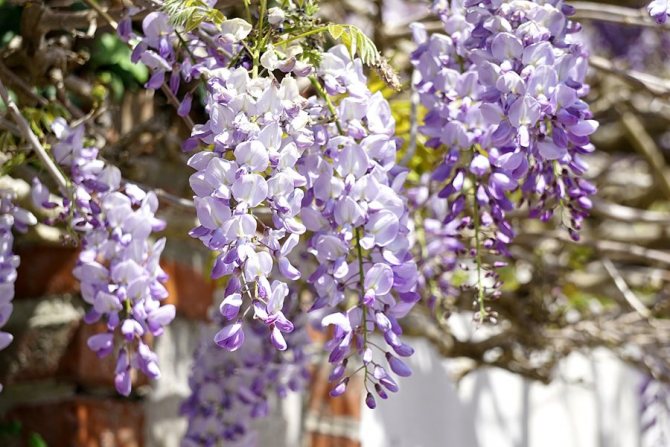

Every year after spring flowering, it is recommended to strongly prune last year's shoots. Their length should not exceed thirty centimeters. With the onset of August, the growth of the previous year should again be shortened by 4-5 buds. The pruning procedure is generally straightforward. If done annually, you can easily get luxurious, fragrant branches.
Systematic pruning will help you shape the wisteria into a standard tree in a short period of time. In this case, it should be planted taking into account the provision of an approach to the plant. The form should be chosen so that it is suitable for indoor growing.
Growing in winter
Indoor crops in winter are provided with a state of rest: the pots are moved to a cool room with an air temperature of no more than +12 ° C. Watering is reduced to 1 time per month. Top dressing is stopped. If you leave the plant in the same conditions, it will waste resources on re-flowering and weaken.
Garden wisterias are prepared for wintering, like climbing roses: the root necks are covered with earth, the lashes are carefully removed from the supports, bent and laid on the ground, having spread a wide sheet of foam rubber, polystyrene or spruce branches below. From above, the shoots are covered with a thick layer of dry leaves, covered with spruce branches and burlap. When winter comes, the bushes will survive the cold under the snow.
In regions with mild winters, you can leave the whips on the supports, covering them with agrofibre or burlap on top.
Planting wisteria seeds
As soon as the root has sprouted, you need to plant the wisteria in the ground. The plant loves warmth, air, water and light. Therefore, a drainage layer must be applied to the flower container. For him, river or sea shells mixed with sand, nutshells, expanded clay are suitable.
Sprinkle a layer of peat on the bottom layer, on the very top of the garden soil mixed with compost. Once the seed is planted in a pot, it must be covered with glass to create a greenhouse effect and retain moisture in the pot. Remove future wisteria for 21 days in a warm, but unlit place.
After three weeks, a sprout with a couple of leaves should appear. Only in five years will such a tree be able to bloom.
Transfer
How is the process going? For transplanting wisteria, the transshipment method is best suited. Young plants up to three years of age should be transplanted into a larger container each year. In the future, it is simply necessary to replace the topsoil with nutritious soil annually.
How does frost-resistant wisteria grow in the Moscow region? The cultivation of this variety allows you to achieve luxurious lush flowering even in our latitudes. In summer, wisteria will become a real decoration of the yard, create a sense of celebration and give a good mood.
Pests and diseases
Wisteria rarely get sick. The correct mode of moistening and feeding ensures the long-term development of plants, and the presence of toxic compounds protects against various pathogens.On saline soils, bushes can suffer from chlorosis - the leaves turn yellow and wither early. To remedy the situation, iron preparations are added to the soil.
Of parasites, lianas are afraid of aphids and clover mites... If leaf damage is detected by pests, shoots should be sprayed abundantly with soapy water with the addition of wood ash powder. Repeat the procedure every 3 days until the insects disappear. If natural remedies do not help, they switch to insecticides and acaricides.
How to care immediately after landing?
First of all, you need to take care of good lighting and protection from drafts.
For the first 5 years, the culture is transplanted every year.
In this case, you do not need to choose too large pots. Otherwise, the plant will only grow green mass to the detriment of flowers.
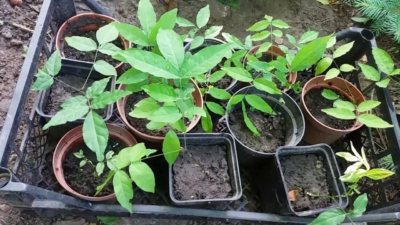

Be sure to remove faded buds during the flowering period. In tree-like street wisteria, the pods are cut after flowering. High-quality pruning is the key to abundant flowering. The lateral and basal processes are removed completely. In the spring, they get rid of new small shoots so that they do not interfere with flowering brushes to grow.
After flowering, the tree is fed with fertilizers containing phosphate and potassium.

